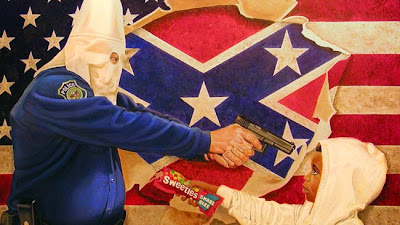FBI’s warning of white supremacists infiltrating law enforcement nearly forgotten
 |
| "A Tale of Two Hoodies" (by Michael D'Antuono artandresponse.com) |
Several key events preceded the report. A federal court found that members of a Los Angeles sheriff’s department formed a Neo Nazi gang and habitually terrorized the black community. Later, the Chicago police department fired Jon Burge, a detective with reputed ties to the Ku Klux Klan, after discovering he tortured over 100 black male suspects. Thereafter, the Mayor of Cleveland discovered that many of the city police locker rooms were infested with “White Power” graffiti. Years later, a Texas sheriff department discovered that two of its deputies were recruiters for the Klan.
In near prophetic fashion, after the FBI’s warning, white supremacy extremism in the U.S. increased, exponentially. From 2008 to 2014, the number of white supremacist groups, reportedly, grew from 149 to nearly a thousand, with no apparent abatement in their infiltration of law enforcement.
This year, alone, at least seven San Francisco law enforcement officers were suspended after an investigation revealed they exchanged numerous “White Power” communications laden with remarks about “lynching African-Americans and burning crosses.” Three reputed Klan members that served as correction officers were arrested for conspiring to murder a black inmate. At least four Fort Lauderdale police officers were fired after an investigation found that the officers fantasized about killing black suspects.
The United States doesn’t publicly track white supremacists, so the full range of their objectives remains murky. Although black and Jewish-Americans are believed to be the foremost targets of white supremacists, recent attacks in Nevada, Wisconsin, Arizona, Kansas and North Carolina, demonstrate that other non-whites, and religious and social minorities, are also vulnerable. Perhaps more alarmingly, in the last several years alone, white supremacists have reportedly murdered law enforcement officers in Arkansas, Nevada and Wisconsin.
In fact, the FBI reports that of the 511 law enforcement officers killed during felony incidents from 2004 to 2013, white citizens killed the majority of them. Of the citizens stopped by law enforcement officers in New York City and Chicago, white citizens were more likely to be found with guns and drugs. Given the white supremacist penchant for violence, guns and drug trafficking, the findings may be an indication that their network is just as destructive and far-reaching as that of foreign terrorist groups.
The unfortunate consequence of today’s threat is that a law enforcement officer may be good or bad, a villain or hero; one exceptionally prone to exhibit malicious forms of racial hatred, or distinctively suited to protect the racially oppressed. But the paradox doesn’t end there.
The white supremacist threat brings to light a dark feature of the American experience that some believed extinct. It rouses ingrained notions of distrusts between police and communities of color while bringing to bear the vital interest citizens of good will share in the complete abolishment of race as a judgmental factor.
As the nation struggles to resolve the perplexities of police brutality, the white supremacist threat should inform all Americans that today’s civil discord is not borne out of a robust animosity towards law enforcement, most of whom are professional. Rather, it’s more representative of a centuries-old ideological clash, which has ignited in citizens of good will a desire to affirm notions of racial equality so that the moral ethos of American culture is a reality for all.
Samuel V. Jones is a former military police captain and currently a professor of law focusing on criminal law at The John Marshall Law School. -Samuel V. Jones (May 12, 2015), Courtesy of The Grio
(If
you enjoyed this post, then please consider subscribing to stay up-to-date with my latest postings and
sharings. Also, please share and support Worldly Game.)



Comments
Post a Comment